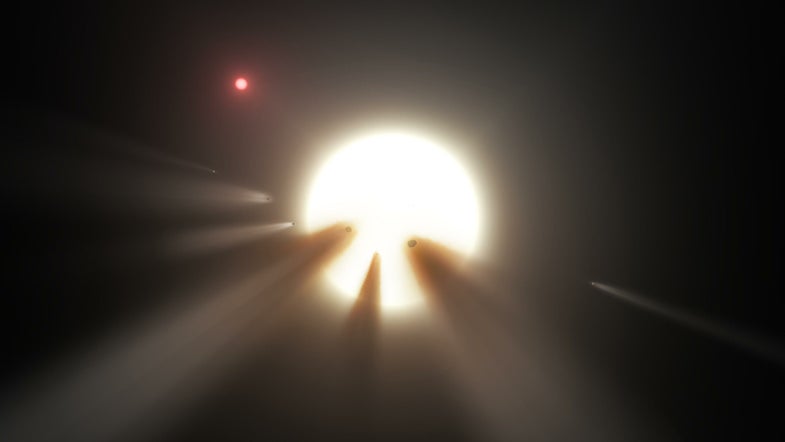Study Confirms That Something’s Weird About The ‘Alien Megastructure’ Star
The mystery around KIC 8462852 probably isn't aliens, but might not be comets either

Astronomers really want to know what’s happening around a star that’s 1,480 light-years away.
In October, astronomers floated the idea that the star KIC 8462852 could be surrounded by some sort of huge alien structure. While that’s unlikely, scientists are still having a hard time coming up with a good explanation for the star’s strange behavior.
Every so often, the star’s light dims by as much as 20 percent. By comparison, a huge, Jupiter-size planet orbitiing the star would block out about 1 percent of the star’s light. Astronomer Jason Wright proposed that a swarm of objects, perhaps alien solar panels, could be circling the star and causing the dimming. Scientists have since listened for radio and laser communications from this hypothetical alien civilization, but found nothing.
Up until now, the leading hypothesis was that a family of comets circles the star, occasionally clumping together to block out huge portions of its light. A new paper, published on the arXiv, says that this explanation is unlikely as well.
You would need 648,000 giant comets to explain the star’s dimming pattern.
Within the paper (which hasn’t been peer-reviewed yet), astronomer Bradley Shaefer from Louisiana State University describes his deep dive into Harvard’s historical astronomy plates. After looking at 1,232 photographic plates from the past century, he found that the star not only dims dramatically over short periods of time today, but also that the star has been growing dimmer over time. These two very strange phenomena are probably linked.
In the past century or so, the star’s brightness has dipped by 16.5 to 19.3 percent. This trend is “completely unprecedented” for a star of this type, Schaefer writes. “Such stars should be very stable in brightness, with evolution making for changes only on time scales of many millions of years.”
He goes on to calculate how many comets would be needed to explain the phenomena, and the answer is: a whole heck of a lot.
Previously, scientists estimated that it would require 36 giant comets to explain the occasional 20 percent dip in light from the star. To explain the century-long fading, Shaefer calculates you’d need 648,000 comets with a diameter of 200 kilometers (124 miles) each. By comparison, the largest known comet in our solar system is 60km in diameter. And the hypothetical comets around KIC 8462852 would need to have a total mass that’s four times the mass of everything in the Kuiper belt.
“I do not see how it is possible for something like 648,000 giant comets to exist around one star, nor to have their orbits orchestrated so as to all pass in front of the star within the last century,” Shaefer writes. “So I take this century-long dimming as a strong argument against the comet-family hypothesis to explain the Kepler dips.”
While Schaefer doesn’t offer an alternative theory, his analysis provides a second line of data suggesting there really is something weird happening around KIC 8462852–that it’s not just a fluke of the Kepler telescope that discovered the star’s odd behavior.
Just because science doesn’t yet have an explanation for what’s happening at KIC 8462852 doesn’t mean it’s aliens. Most major discoveries don’t have an obvious explanation at first. But whatever is happening on this faraway star, it’s sure to be something interesting.